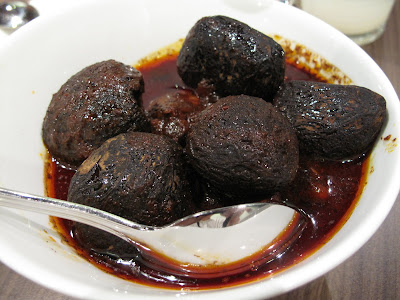
For those who want a quick introduction, Candlenut Kitchen is a fairly new restaurant along Neil Road serving traditional Peranakan cuisine in air-conditioned comfort. Nyonya food, despite its deceptive homeliness, is not at all easy to cook, being extremely labour-intensive, which may explain why there are relatively few Peranakan restaurants in Singapore. Candlenut Kitchen aims to bring the same sort of love and devotion to the preparation, cooking and serving of Peranakan food that Straits Chinese matriarchs would have expected or demanded from new daughters-in-law.
The restaurant is not very large, accommodating about thirty people, but when I was there on a Monday evening the restaurant was almost full: a good sign, and probably attributable, among other things, to Chubby Hubby's positive remarks. A quick sampling of other food blog reviews though, seems to indicate that diners so far have had a favourable impression. Of course, it helps that the prices aren't exorbitant - dinner came up to about $25 per person.

Candlenut Kitchen does not have a very extensive menu, so chances are most people will end up having the same dishes, which is not necessarily a bad thing, considering that certain dishes simply spring to mind when you think of Nyonya cuisine. Like kueh pai tee, for instance. Although the pastry shell could have been crispier, the consensus was that the filling was excellent, as the natural sweetness of the turnip was immediately evident, and the filling itself was nicely moist without being wet.

I'm not entirely sure what makes a good chap chye, since it's essentially stewed vegetables. In fact, I'm not even sure what goes into chap chye, or how it's made, so that leaves me rather unqualified to comment.

Ayam buah keluak is a rich curry containing chicken and the eponymous buah keluak, which is a nut or seed from the kepayang tree (pangium edule) and is, as wikipedia explains, deadly poisonous without the right preparation. In any event, Candlenut Kitchen's ayam buah keluak is not poisonous, but delicious: the chicken is meltingly tender without being overcooked, and the sauce is lip-smackingly good, with a slightly sour tang that enlivens the curry.

Sambal is the spicy hallmark of many South-East Asian cuisines, and it features heavily in Nyonya food. At Candlenut Kitchen, sambal petai, a hot concoction of red chillis, garlic, shallots and petai beans is served with prawns - a fairly classic combination. Avoid the petai beans if you are not a fan of strong-smelling foods (they are also known as "stinky" beans), as the sambal is piquant enough to stand on its own.

The great thing about eating ethnic food is that the research after is almost as enjoyable as the food itself. Ngor hiang for instance, a sausage-like thing that consists of a meaty filling wrapped in a fried beancurd skin, seems to be more a Hokkien dish than a Peranakan one, but understandably with much cross-pollination between the Malay and Chinese communities, it is unsurprising that neither ethnic/racial group can lay absolute claim to a dish as their peculiar heritage.

Candlenut Kitchen serves two different types of curry (not including the ayam buah keluak): the traditional chicken curry, and a "Yeye's curry", a thick, almost creamy, white pepper-based curry that is evidently a family recipe. Adorned with lime leaves, this white curry tastes (and looks) like a Thai green chicken curry, which is perhaps why I think I would have preferred the traditional orange chicken curry.

Every cuisine seems to have its own version of pork belly, my sister commented over a meal at Spice Peranakan (more on that in a later post), and babi garam assam is a pork belly simmered in tamarind, before being thinly sliced and seared over a hot pan. Candlenut's version was generously doused with sauce, though, which attenuated the desired charring somewhat.

Sotong sambal is another Peranakan classic, and the one we had was very deftly handled. The sambal was not extremely spicey, which was fine by me, but the squid was cooked just right, retaining its firmness at first bite, which then gives way to a delicate chewiness that is not marred by any rubbery texture.

The desserts at Candlenut Kitchen are also very enticing. The banana cake, served with vanilla ice cream, is redolent with the scent and taste of ripe bananas, and suitably moist that you don't even notice when you're halfway through one.

Thus far all the food has been eminently traditional, and what you'd expect if someone invited you to their house for a home-cooked meal of Nyonya food - Chef Malcolm is clearly not aiming to reinvent Peranakan cuisine. The only exception, however, is the chendol cream, which is basically a deconstructed version of chendol, involving a coconut milk pudding, that's topped with gula melaka (brown palm sugar syrup) and pandan noodles. While unpopular with chendol purists like my father, I found this to be the best dish of the night, partially because these are the ingredients of chendol I like most anyway (not including attap seeds). As a matter of culinary experimentation, too, the chendol cream is a success: the fragrance of the coconut cream is rich and powerful, but rounded off by the butterscotch-caramel flavours of the gula melaka, which provides a great colour contrast that is further enhanced by the bright green chendol "worms".
Candlenut Kitchen is just starting out and making a name for itself, and is a welcome addition to the food scene in Tanjong Pagar. It offers a great set lunch at only $10, and is of course a good venue for communal dining.
Candlenut Kitchen
25 Neil Road
Tel: +65 6226 2506
Website
Opening Hours: Monday to Saturday 1130 am - 3pm and 6pm - 1030 pm (Closed on Sunday + Public Holidays)



1 comment:
Thanks for the lovely review.
Post a Comment